Alumni
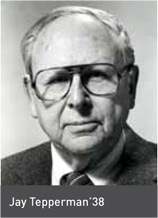 1938
1938
Jay Tepperman, emeritus professor of experimental medicine at SUNY Upstate Medical University at Syracuse, N.Y., died Dec. 20, 2012. Dr. Tepperman was a recognized authority on biochemical endocrinology. On an alumni questionnaire he recalled, “It was a privilege to be a medical student during a fearful Depression.” On the same questionnaire he was proud to report that he had “helped in the education of more than 4,000 physicians and scores of PhD candidates.” He and his wife, Helen Murphy Tepperman, PhD, who survives him, operated what he characterized as “a Mom and Pop research lab” for more than 40 years at SUNY Syracuse. He and his wife received honorary degrees from the State University of New York at the Health Science Center at Syracuse. They collaborated on a widely read textbook, “Metabolic and Endocrine Physiology.” He is also survived by two daughters, a son, and five grandchildren. Dr. Tepperman was a staunch supporter of P&S.
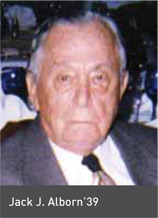 1939
1939
Jack J. Albom, a retired dermatologist and clinical professor of dermatology at Yale Medical School, died Nov. 12, 2012, at age 99. Following his official retirement he served for many years as a consultant in dermatology at the VA Hospital in Pompano Beach, Fla. Preceded in death by his wife, Miriam, he is survived by two daughters, five grandchildren, and four great-grandchildren.
1942
Fay Perry Greene, a retired general physician and surgeon, died Oct. 27, 2012. Dr. Greene served in the U.S. Army Air Force during World War II. After the war he moved to Parkersburg, W.Va., where he pursued a general medical and surgical practice for more than 50 years, often accepting eggs in lieu of payment from grateful but hard-hit patients. Outside of his medical practice, he ran two farms and served as a surgeon for the B&O Railroad, president of the Parkersburg Medical Society, and chief of staff of St. Joseph’s Hospital. Dr. Greene also served as a surgical consultant to Trinidad and Tobago, where he had a second home. He also found time to be a teacher, pilot, athlete, and world traveler. Preceded in death by his wife, Genevieve, he is survived by two daughters, a son, eight grandchildren, and six great-grandchildren.
1943D
William Sinclair Jr., a retired pathologist and longtime member of the clinical faculty in the Department of Pathology at Case Western Reserve Medical School, died Jan. 30, 2013, at age 94. Dr. Sinclair served as a medical officer in the U.S. Navy during World War II, participating in the D-Day invasion with the first wave at Omaha Beach in Normandy. He later founded the pathology department laboratory and school of medical technology at Lutheran Medical Center in Cleveland, Ohio, and served as director for 35 years. He taught for many years on the clinical pathology faculty at Case Western Reserve, where he was honored with the 2006 Pillar of Medicine Award. Outside of medicine he belonged to Ski Docs, the Pasteur Society, and the Cleveland Photographic Society. Preceded in death by his first wife, Joan, and a grandson, he is survived by his second wife, Barbara, a daughter, two sons, seven grandchildren, and four stepgrandchildren.
1945
Robert C. Wheeler, a former clinical professor of pediatrics at P&S, died March 30, 2013. He was 93. Dr. Wheeler served in World War II as a lieutenant in the U.S. Navy, participating in early studies of streptomycin as a treatment for tuberculosis. He was affiliated for many years with Greenwich Hospital in Greenwich, Conn., where he served as a member of the staff in the emergency department. Volunteering with Care-Medico, Dr. Wheeler helped re-open the pediatric service of the hospital in Beni Messous, Algeria, which had been damaged during the war, and taught emergency medicine in Java, Indonesia. He was a member of the Sons of the American Revolution. Preceded in death by two daughters, he is survived by a daughter, a son, five grandchildren, and four great-grandchildren.
1946
Harold Gabel, a retired internist who had been a member of the teaching staff at Monmouth Medical Center in Long Branch, N.J., for more than 60 years, died Aug. 12, 2013, 11 days after the death of his wife, Adelaide. He was 90. Dr. Gabel served in the U.S. Army from 1943 to 1950. Following his official retirement from private practice in 2010, he continued to volunteer at the Parker Clinic in Red Bank. He is survived by a daughter, six sons, and 15 grandchildren.
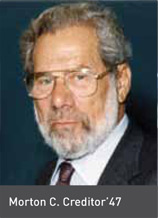 1947
1947
Morton C. Creditor died Dec. 30, 2012. Dr. Creditor served in the U.S. Navy, pursuing his medical studies in uniform during World War II. He taught on the faculty of the University of Kansas School of Medicine and later moved to Chicago, where he served as director of the Illinois Regional Medical Program, then as associate dean of medicine at the University of Illinois with responsibility for leading the development of the Clinical School of Medicine at the University of Illinois at Urbana-Champlain. He was later appointed interim executive dean of the entire university, the school with the largest enrollment in the country. Following a sabbatical year, he returned to found the Geriatrics Medicine Program at the University of Illinois and subsequently returned to the University of Kansas Medical Center, where he founded the Center on Aging. He is survived by his wife, Una, two daughters, two sons, a stepdaughter, and a stepson.
1949
William “Bunky” Wallop, a retired radiologist, died of a brain tumor on June 1, 2013. Dr. Wallop pursued his undergraduate degree at Princeton in the Navy V-12 Program and following graduation from medical school was stationed for two years in Japan with the U.S. Air Force Medical Corps. Dr. Wallop served as a member of the staff in the Department of Radiology at Arundel General Hospital in Annapolis, Md., before starting his own practice. He was a past president of the Maryland Radiology Society. Preceded in death by a son, he is survived by his wife, Rosemary, three daughters, two sons, and 16 grandchildren.
1952
Leonard H. Brandon, a semiretired family practitioner, died June 7, 2013. He was 86. In the course of his career, Dr. Brandon held positions as chief of staff at Oktibbeha County Hospital, president of Prairie Medical Society, and member of the board of trustees of the Mississippi State Medical Association. In 2004 he was saluted as Family Physician of the Year by the Mississippi Academy of Family Physicians, of which he had previously served a term as president. He is survived by his wife, Rachel, a daughter, three sons, six grandchildren, and two great-grandchildren.
 Arthur P. Hall, a retired internist and rheumatologist and former associate clinical professor of medicine at Harvard Medical School, died Feb. 19, 2013. Dr. Hall served in the U.S. Army Air Corps. He practiced internal medicine and rheumatology for more than a half century as a member of the staff at Brigham and Women’s Hospital in Boston. Preceded in death by his wife, Martha, he is survived by two daughters, two sons, six grandchildren, and one great-grandchild.
Arthur P. Hall, a retired internist and rheumatologist and former associate clinical professor of medicine at Harvard Medical School, died Feb. 19, 2013. Dr. Hall served in the U.S. Army Air Corps. He practiced internal medicine and rheumatology for more than a half century as a member of the staff at Brigham and Women’s Hospital in Boston. Preceded in death by his wife, Martha, he is survived by two daughters, two sons, six grandchildren, and one great-grandchild.
Herbert C. Haynes, a retired psychiatrist known by his classmates as “Pat,” died Sept. 9, 2013, at age 93. During World War II he worked at the Johns Hopkins Applied Physics Lab on the development of the “proximity fuze,” a fuse that automatically detonates an explosive, considered one of the key technological innovations credited with shortening the duration of the war. After earning his MD from P&S, he pursued a psychiatric residency at Walter Reed Army Medical Center and Saint Elizabeth’s Hospital, then served as an Air Force flight surgeon. He served for many years as chief of psychiatric services for the Federal Aviation Agency, where he created and headed a new behavioral science division responsible for certifying the mental health of all commercial and private pilots and air traffic controllers. In 1976 he established the first in-house mental health division in the U.S. Department of State. Upon his official retirement, he returned to his native West Virginia to serve as chief medical officer and clinical director of Weston State Hospital, the state’s largest institution devoted to mental health. Survivors include his wife, Ann Elizabeth, five children from his first marriage, a stepson, seven grandchildren, two stepgrandchildren, and three great-grandchildren.
1954
Thomas R. Holland, a retired internist, died June 16, 2013. Dr. Holland served in the U.S. Army based in South Korea from 1944 to 1946. He pursued a private practice for close to 30 years in Morristown, N.J., where he was also affiliated in various positions, including chief of the hematology/oncology service at Morristown Memorial Hospital. He is survived by his wife, Eneida, three daughters, and a son.
Arthur A. Like, a retired endocrinologist specializing in diabetes, died June 9, 2013. He served as a captain in the U.S. Army in Germany. A former member of the faculty in the Department of Medicine at Harvard Medical School, affiliated with the Peter Bent Brigham Hospital (now Brigham and Women’s) and the Joslin Diabetes Center, he later moved to the University of Massachusetts Medical School in Worcester. Dr. Like pursued research on the immunology of insulin-dependent diabetes mellitus in the Bio-Breeding/Worcester rat animal model. Preceded in death by his first wife, Carol, he is survived by his second wife, Betty, 12 children, 28 grandchildren, and two great-grandchildren.
1955
Thornton W. Merriam, a retired internist who specialized in chemical dependency, died April 28, 2013. He served in the U.S. Navy Medical Corps. Dr. Merriam had been affiliated with Eastern Maine Medical Center Acadia Hospital in Bangor, Maine. Following his official retirement he continued to see patients on a part-time basis at the hospital’s Narcotics Treatment Program. Survivors include his wife, Mary, four daughters, and a son.
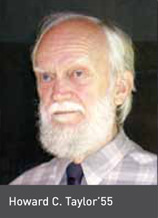 Howard C. Taylor, a former medical examiner and state forensic psychiatrist for the State of Vermont, died Oct. 23, 2012, at age 83. His lifelong curiosity and active imagination led him to invent a rotating star-watching chair and to participate as a member of the first crew to winter at the South Pole. He is survived by his wife, June, three daughters, and four grandchildren.
Howard C. Taylor, a former medical examiner and state forensic psychiatrist for the State of Vermont, died Oct. 23, 2012, at age 83. His lifelong curiosity and active imagination led him to invent a rotating star-watching chair and to participate as a member of the first crew to winter at the South Pole. He is survived by his wife, June, three daughters, and four grandchildren.
1957
Pier L. Mancusi-Ungaro, an internist in private practice for more than 40 years who maintained affiliations with Mountainside Hospital of Montclair, N.J., and Columbia, died Sept. 11, 2013. He served as a physician in the U.S. Army, rising to the rank of captain. Through much of his career Dr. Mancusi-Ungaro served at the free public medical clinic at Columbia and bucked the norm by continuing to do house calls. Survivors include his wife, Sally, a daughter, a son, and three grandchildren.
 1958
1958
Stephen E. Malawista, the distinguished rheumatologist best known as the lead investigator of the team of research scientists at Yale (including Allen C. Steere Jr.’69) that cracked the mystery of Lyme disease, died of metastatic melanoma Sept. 18, 2013. He was 79. Observing that greater numbers of deer tended to gather on the east side of the Connecticut River, where clusters of cases of a then-unidentified condition characterized by severe rashes, swollen joints, and sometimes debilitating neurological symptoms had been reported, Dr. Malawista and his team established by ingenious medical detective work that a spirochete carried by a tick that bred on the backs of deer was the likely culprit, dubbed the condition Lyme disease (after Lyme, Conn.), and recommended antibiotics to treat it. Dr. Malawista and his colleagues were honored for their discovery in 1985 with the prestigious Ciba-Geigy-ILAR Rheumatology Prize. A professor of medicine and chief of rheumatology at Yale University School of Medicine, he was also known for his research in leukocyte motility and microbicidal activity, the mechanism of action of colchicine and the pathogenesis of gouty arthritis. Longtime rheumatology editor for the Year Book of Medicine and a past president of the American College of Rheumatology, he was the author of more than 150 original articles and more than 100 reviews and book chapters, the latter in such respected volumes as “Cecil’s Textbook of Medicine,” “Rich’s Clinical Immunology,” “Koopman’s Arthritis and Allied Conditions,” and “The Merck Manual.” He received an honorary degree from the Université René Descartes in Paris, a Guggenheim Fellowship, the 2003 Gold Medal of the American College of Rheumatology, and the 2006 Gold Medal of the P&S Alumni Association. He is survived by his wife, Tobé.
1960
John R. Sachs, a professor of medicine emeritus at Stony Brook University Medical School noted for his research on red blood cells, died July 17, 2013. Dr. Sachs served in the U.S. Army from 1966 to 1969, stationed at Walter Reed Army Institute of Research, where he pursued studies that led to the treatment of soldiers in Vietnam stricken with a rare blood disease. He taught for some years at Yale University School of Medicine before joining the faculty of Stony Brook University Medical School as a founding member and later head of the Division of Hematology. He also was a member of the staff at Northport Veterans Hospital. Dr. Sachs contributed to several textbooks, notably “The Red Blood Cell and Red Cell Membrane Transport.” He is survived by his wife, Marilyn, two daughters, a son, and two grandchildren.
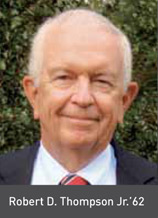 1962
1962
Robert D. “Denny” Thompson Jr., a retired internist who specialized in nephrology, died of pneumonia April 29, 2013. Dr. Thompson served in the U.S. Air Force as a physician assigned to the Strategic Air Command. A former clinical professor of medicine at Case Western Reserve, he served for more than five decades as attending physician at University Hospitals of Cleveland, where he co-founded an end-stage renal program. He also served for many years as a member of the board of trustees of the Centers for Dialysis Care, which he had founded. He was a former chair of the board of trustees of University Suburban Health Center. Among his greatest satisfactions, he once wrote on an alumni questionnaire, “I have been fortunate to see the science of organ transplantation evolve from its infancy to being a standard form of therapy.” He is survived by his wife, Carolyn, a daughter, and
two grandchildren.
 1964
1964
David S. David, a nephrologist and member of the medical team that cared for the first dialysis and kidney transplant patients in New York, died April 9, 2013. Dr. David served in the U.S. Army Reserves. He was a member for many years of the teaching faculty in the Department of Medicine at New York Hospital/Cornell Medical Center. Dr. David is survived by his wife, Vera, a daughter, a son (Eric David’02), and three grandchildren.
1965
William B. Caskey, an internist specializing in endocrinology, died May 21, 2013. He was long associated with United Health Group and previously served as chair of endocrinology, CEO, and vice president of clinical development at the St. Francis Medical Center in Lawrenceville, N.J., where he was instrumental in establishing the first catheterization laboratory. Dr. Caskey was a past president of the Mercer County Medical Society. He is survived by his wife, Mary, two sons, and two grandchildren.
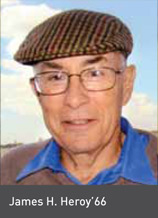 1966
1966
James H. Heroy, a respected otolaryngologist and head and neck surgeon, died March 13, 2013. He served as a medical officer and surgeon in the U.S. Navy. After pursuing a private practice in Fallston, Md., he moved to Las Vegas and joined Ear, Nose and Throat Consultants of Nevada. Survivors include his wife, Karen, two daughters, a son, and four grandchildren.
Donald L. Snider, a former chair of the board of directors of Health Care Excel, a consulting firm dedicated to assisting health care professionals deliver quality, cost-effective care, died Feb. 16, 2013. Long affiliated with Good Samaritan Hospital in Vincennes, Ind., he was a past president of the Knox County Indiana Medical Society and a member of the board of directors of the Impaired Physicians Committee of the Indiana State Medical Association. He was the recipient in 2004 of the Sagamore of the Wabash, the highest civilian award in the state of Indiana. He is survived by his wife, Dona, two daughters, a son, and a granddaughter.
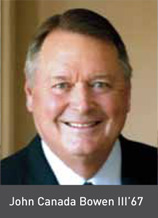 1967
1967
John Canada Bowen III, a vascular and gastrointestinal surgeon, died of cancer May 13, 2013. A member of the clinical faculty in the Department of Surgery and Physiology at the Louisiana State University School of Medicine, Dr. Bowen was chairman emeritus of the Department of Surgery at Ochsner Clinic Foundation Hospital in New Orleans. A member of the board of trustees at the Alton Ochsner Medical Foundation and of the board of governors of the Ochsner Clinic, he served as a past president of the American Surgical Society and the Society for Surgery and the Alimentary Tract. Dr. Bowen served as a captain in the 24th Evacuation Hospital in Vietnam, earning a Bronze Star, and subsequently pursued research in the Division of Surgery at the Walter Reed Army Institute of Research in Washington, D.C. He is survived by his wife, Mimi, a daughter, and a son.
1969
Dennis C. Turner, a psychiatrist, died of cancer May 20, 2013. A member of the clinical faculty in the Department of Psychiatry at California Pacific Medical Center, Dr. Turner trained at the C.G. Jung Institute of San Francisco and pursued a career as a Jungian analyst.
1971
Robert G. Hickes, an internist specializing in hematology-oncology based in Ithaca, N.Y., died July 30, 2013. Following many years of private practice he became a hospitalist at Crouse Hospital in Syracuse, N.Y. He is survived by his wife, Carol, two daughters, a stepdaughter, and a stepson.
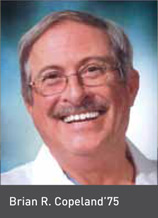 1975
1975
Brian R. Copeland, a respected neurosurgeon, died June 8, 2013. He taught on the faculty at the University of California at San Diego and served as medical director of gamma knife radiosurgery and as senior staff neurosurgeon at Mid Michigan Medical Center in Midland, Mich. Dr. Copeland previously spent two decades as a research scientist at Scripps Research Institute and saw patients at Scripps Clinic in La Jolla, Calif., where he headed up the Division of Neurosurgery. He was also chair of the Department of Neurosciences at San Diego’s Children’s Hospital. He is survived by his wife, Margaret, and two stepchildren. Among his greatest joys outside of medicine, he once noted on an alumni questionnaire, was having climbed the Matterhorn in Switzerland on his 40th birthday.
1985
Frederick L. Brancati, a respected epidemiologist, died of amyotrophic lateral sclerosis May 14, 2013. He was professor of medicine and epidemiology at Johns Hopkins University, where he served for many years as director of the Division of General Internal Medicine. Dr. Brancati pursued research on the clinical epidemiology of type 2 diabetes and its complications. He focused, in particular, on health trends based on age, race, and ethnicity and on risk prediction for diabetic patients. He and his research team established that the A1c test was more accurate than the glucose tolerance test in predicting cardiovascular disease and diabetes. He served as chair of various committees at the CDC. In 2011 he received the Kelly West Award for Outstanding Achievement in Epidemiology from the American Diabetes Association and the Chief of the Year Award from the Association of Chiefs and Leaders of General Internal Medicine. A beloved mentor to many students and residents, he was awarded the Johns Hopkins University Diversity Award.
Survivors include his wife,
Dr. Elizabeth M. Jaffee,
and two daughters.
1988
Sandra Joy Gatt, a plastic surgeon who practiced in Princeton, N.J., died Aug. 2, 2013. In her private practice she treated many women with breast cancer. She is survived by her husband, Charles, and two sons.
- Log in to post comments

